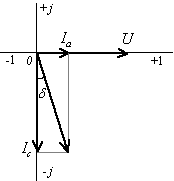Dielectric loss
In many practical applications real dielectric may be considered as an ideal capacitor, connected in parallel with the resistor. Current through the resistor represents all the losses in dielectric caused by different physical effects - electrical conductivity (Joule losses), polarization. Vector sum of the active current Ia and displacement current Ic makes the total current I.

Angle between the total current and active current is usually called δ (Delta), and tg(δ) = Ia/Ic is a parameter which defines the dielectric losses - Dissipation Factor (DF). In good capacitor is usually small, δ ~ DF, and DF is often expressed as a percentage.

Simulation of the dielectric losses in the material with known dissipation factor (a.k.a. loss factor, or loss tangent) may be performed with QuickField
References:
Simulation of the dielectric losses in the capacitor with known loss tangent,
Wikipedia, Dielectric_loss.